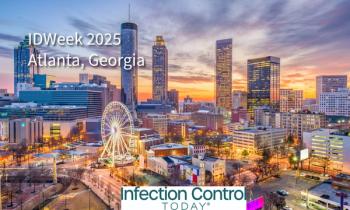
Ultraviolet Irradiation Boosts Cleansers’ Effect, but Much Hinges on How Well EVS Teams Function
For ABC, the bacterial counts were 56% lower for post-manual cleaning plus UV, compared with manual cleaning alone. For MRSA, they were 93% lower.
Ultraviolet (UV) irradiation boosts the cleaning ability for all cleaners and disinfectants when it comes to reducing the bioburden in hospital patient rooms but really enhances the results of less potent solutions perhaps because there’s just more room for improvement. So say investigators with the Veterans Administration (VA) who looked at samples of methicillin-resistant Staphylococcus aureus (MRSA) and aerobic bacterial colonies (ABC) obtained from 5 high-touch surfaces in patients’ rooms: bedrail, call button, toilet seat, bathroom handrail, and tray table.
The study1 in Open Forum Infectious Diseases, a publication of the Infectious Diseases Society of America, was conducted at a 120-bed acute care VA hospital in Temple, Texas. Samples came from single-occupant rooms that had been used for at least 48 hours and in which the patient had been discharged before 3 PM on the day the samples were collected.
Collection occurred before manual cleaning, after manual cleaning using 1 of 3 disinfectants or 1 cleaner, and after UV irradiation, a total of 600 samples for each stage.
After collection of the post-cleaning samples, a UV device, manufactured by Xenex Disinfection Systems, was used 3 times-a 5-minute cycle on each side of the patient bed and a 5-minute cycle in the restroom. Post-UV samples were taken after completion of the UV irradiation. “Plated colonies were counted and recorded by a laboratory technician in a blinded manner,” the study states.
For ABC, the bacterial counts were 56% lower for post-manual cleaning plus UV, compared with manual cleaning alone. For MRSA, they were 93% lower for post-manual plus UV versus manual cleaning alone. The cleansers and disinfectants used included sodium hypochlorite 10% solution, hydrogen peroxide with peracetic acid, or detergent.
Investigators also measured the effectiveness of the environmental services (EVS) cleaning crews. The study states that, “Variability in EVS staff performance was included in the analysis by allowing the baseline mean bacterial colony counts to vary with each individual staff member.”
Some EVS personnel cleaned better than others, according to the results.
The study’s corresponding author, Chetan Jinadatha, MD, a lead researcher with the Central Texas Veterans Health Care System, told Infection Control Today®“that guideline-based EVS training can definitely improve appropriate disinfection.”
Sylvia Garcia-Houchins, MBA, RN, CIC, director of infection prevention and control within the division of healthcare improvement at the Joint Commission, said that, in general, Commission surveyors use the tracer methodology to look at the cleaning and disinfection processes at facilities to identify potential vulnerabilities. “If issues are identified they might ask the organization for more specific information including applicable regulations, [US Centers for Medicare and Medicaid Services] requirements (if deemed), manufacturer instructions for use, and the organization’s chosen evidence-based guidelines and policies,” Garcia told ICT®.
Jinadatha’s feedback is that, according to his study, the effectiveness of various chemical disinfectants and cleansers on some of the organisms varied. In addition, said Jinadatha, varying outcomes for each chemical could be attributed to how long the cleanser was used on the surface, the potency of the cleanser or disinfectant when used, or even how much ABC or MRSA was on the surface in the first place.
References:
Zeber JE, Coppin JD, Villamaria FC, et al. Use of ultraviolet irradiation in addition to commonly used hospital disinfectants or cleaners further reduces the bioburden on high-touch surfaces. Open Forum Infect Dis. 2019 Dec 17;6(12):ofz529. doi: 10.1093/ofid/ ofz529. eCollection 2019 Dec.
Newsletter
Stay prepared and protected with Infection Control Today's newsletter, delivering essential updates, best practices, and expert insights for infection preventionists.




